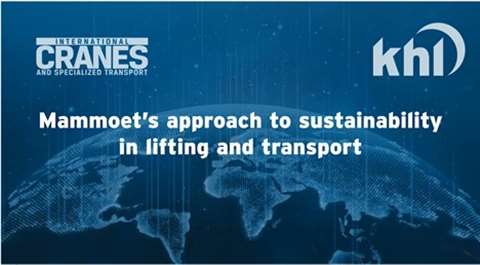Interview: Mammoet’s Erica Gray on adopting sustainability
05 August 2021
Erica Gray, global sustainability manager at Mammoet, tells ICST about the company’s strategic approach to sustainability
Over the past three years Mammoet has tightened its approach to sustainability, implementing an umbrella approach to tackle the subject in a strategic manner.
After analysing what businesses in similar sectors were doing on sustainability, the wider business environment, on top of what customers were doing and what they wanted, Mammoet put together its ‘sustainability roadmap’.
This also incorporates evaluation of sustainability work Mammoet has been doing to date, the idea being not to duplicate things that were already happening but to identify areas where it could do more and pinpoint areas that aligned with its customer’s green aspirations.
The roadmap outlines four key areas of focus: market leadership; sustainable engagement; efficient operations; and being a responsible employer. This provides a structured framework under which achieving effective change can be tackled.
Although sustainability is broad by nature, key areas of focus are incorporated into the roadmap – with carbon reduction being high on the list of priorities.
 Erica Gray is enthusastic about Mammoet’s ‘efficient operations’ theme
Erica Gray is enthusastic about Mammoet’s ‘efficient operations’ theme
Gray explained, “It is one of our biggest impacts. We have a large, diverse fleet of equipment most of which still runs on conventional diesel.
“This accounts for most of our emissions so we are very focused on carbon reduction via decarbonisation of our transport and lifting equipment.”
Under Mammoet’s ‘sustainable engagement’ initiative, the company is also working in partnership with both clients and suppliers on lowering the carbon footprint of projects.
Gray added, “This is not just to make them more carbon efficient but it ties in with our ‘efficient operations’ theme of exploring new ways of doing things or innovating new products that help us to reduce our carbon footprint.”
This approach extends to other emissions, such as water and waste, and even includes fostering community engagement.
When Mammoet first put together its roadmap in 2018 it set a number of targets, but given the uncharted nature of the heavy lift and transportation sustainability sector some of the targets are currently being revised and the number of targets reduced.
Gray said, “This is a reframing to gain greater insight. For example, we previously said we wanted X percentage of the fleet to be carbon neutral but how do you actually measure that across different fleets, especially considering the fleet has expanded with the acquisition of ALE?
“By revising our targets we are trying to make it really clear to people what we are trying to achieve, and so that we can focus our energies on the areas we can have the most impact.
One of the key headline targets for Mammoet is to reduce its carbon footprint by 30 per cent by 2030.
Gray commented, “One angle we have been exploring to help achieve this is the use of alternative fuel, specifically HVO fuel, for both SPMT and in some of our cranes.
“In addition, we are currently trialling electric powerpacks for our Scheuerle SPMTs. Electric powerpacks already exist, but not for the kind of heavy loads we are looking to move.”

Click here to view video of the interview with Erica Gray, Mammoet’s global sustainability manager
Mammoet has aligned its own roadmap targets with the Paris agreement and the UN sustainable development goals. It uses a science-based target methodology to quantify effectiveness, a process it is still going through.
Gray explained, “This is a really new field, particularly for heavy lifting and transport.”
Until now Mammoet has calculated its fleet emissions based on fuel consumption, but the company’s aim is to see more information based on individual bits of equipment.
Gray added, “So far we have made some really big steps and, as we move forward, the approach will mature and we will be in a much better position to look at the targets and the data and come to real-time conclusions.”
One way of achieving this is by taking data directly out of the equipment so it can directly measure emissions.
Gray elaborated, “This is possible due to technological developments in data capture plus the Internet of Things (IoT). Once you have got that sort of data coming out of the equipment, it gives you a huge amount of opportunity in terms of how you use that data to make decisions about how you improve.
“In the future a company’s performance will no longer be assessed in terms of finances and profit and loss. Businesses will need to share some form of non-financial reporting and sustainability is likely to be a big part of that. We have set up robust systems to enable this type of reporting and act based upon whatever data we get.”
 Changing human behaviour is another area that Mammoet is exploring as part of its roadmap
Changing human behaviour is another area that Mammoet is exploring as part of its roadmap
One of the main challenges facing Mammoet from achieving its targets is the pioneering nature of the sector. Changing human behaviour is another area that Mammoet is exploring as part of its roadmap.
Gray said, “Nobody has really done this work before for the kind of business that we are so we started with a blank piece of paper. Whilst that is exciting and there are lots of opportunities, it is a steep learning curve.
“Getting people to change the way that they act, the way they use the equipment for example, also brings challenges. Understanding why people behave as they do is key to this.
“These issues are not just a problem for Mammoet, they are also a problem for all businesses in our industry and our customers and our suppliers. I say ‘problem’ but actually there are huge opportunities here because the world is going to have to change.
“The fossil fuel dependence that we have all been used to for decades is changing creating exciting opportunities, particularly for collaboration and partnership working. In order to crack this particular nut we need to be working together because at the end of the day it’s for all of our benefit.”
Click here to view video of the interview with Erica Gray, Mammoet’s global sustainability manager
STAY CONNECTED


Receive the information you need when you need it through our world-leading magazines, newsletters and daily briefings.



